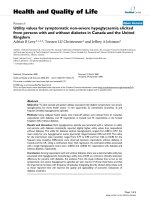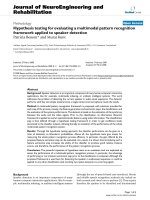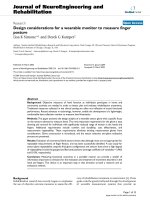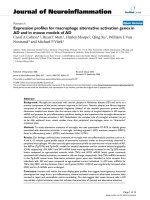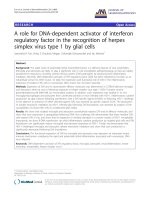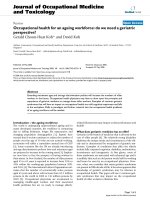Báo cáo hóa học: " Maximal -inequalities for demimartingales" pdf
Bạn đang xem bản rút gọn của tài liệu. Xem và tải ngay bản đầy đủ của tài liệu tại đây (274.35 KB, 10 trang )
RESEARC H Open Access
Maximal -inequalities for demimartingales
Xiaobing Gong
1,2
Correspondence:
1
Key Laboratory of Numerical
Simulation of Sichuan Province,
Neijiang, Sichuan 641112, China
Full list of author information is
available at the end of the article
Abstract
In this paper, we establish some maximal -inequalities for demimartingales that
generalize the results of Wang (Stat. Probab. Lett. 66, 347-354, 2004) and Wang et al.
(J. Inequal. Appl. 2010(838301), 11, 2010) and improve Doob’s type inequality for
demimartingales in some cases.
Mathematics Subject Classification (2010): 60E15; 60G48
Keywords: demimartingale, maximal -inequalities, Doob’s inequality
1. Introduction
Definition 1.1 Let S
1
, S
2
, be an L
1
sequence of random variables. Assume that for
j =1,2,
E{(S
j
+1
− S
j
)f (S
1
, , S
j
)}≥
0
(1:1)
for all componentwise nondecreasing functions f such that the expectation is defined.
Then {S
j,
j ≥ 1} is called a demimartingale. If in addition the function f is assumed to
be nonnegative, the sequence {S
j,
j ≥ 1} is called a demisubmartingale.
Remark.Ifthefunctionf is not required to be nondecreasing, then the condition
(1.1) is e quivalent to the condition that {S
j
, j ≥ 1} is a martingale with the natural
choice of s-algebras. If the function f is assumed to be nonnegative and not necessarily
nondecreasing, then the condition (1.1) is equivalent to the condition that {S
j
, j ≥ 1} is
a submartingale with the natural choice of s -algebras. A martingale with the natural
choice of s-algebras is a demimartingale. It can be checked that a submartingale is a
demisubmartingale ( cf. [[1], Proposition 1]). However, there are stochastic processes
that are demimartingales but not martingales with the natural choice of s-algebras (cf.
[[1], example A], [[2], p. 10]). Definition 1.1 is due to Newman and Wright [3].
Relevant to the notion of demimartingales is the not ion of positiv e dependence. To
that end, we have the following definition.
Definitio n 1.2 A finite collection of random variables X
1
, X
2
, ,X
m
is said to be
associated if
Cov{f
(
X
1
, X
2
, , X
m
)
, g
(
X
1
, X
2
, , X
m
)
}≥
0
for any two componentwise nondecreasing functions f, g on R
m
such that the covariance
is defined. An infinite collection is associated if every finite subcollection is associated.
Remark.Associatedrandomvariableswereintroduced by Esary et al. [4] and have
been found many applications especi ally in reliability theory. Proposition 2 of Newman
and Wright [3] shows that the partial sum of a sequence of mean zero associated ra n-
dom variables is a demimartingale.
Gong Journal of Inequalities and Applications 2011, 2011:59
/>© 2011 Gong; licensee Springer. This is an Open Access article distributed under the terms of the Creative Commons Attribution
License ( y/2.0), which permits unrestricted use , distribution, and reproduction in any medium,
provided the original work is properly cited.
The connection between demimartingales and martingales pointed out in the previous
remark raises the question whether certain results and especially ma ximal inequalities
valid for martingales are also valid for demimartingales. Newman and Wright [3] have
extended various results including Doob’ s maximal inequality and Doob’ supcrossing
inequality to the case of demimartingales. Christofides [5] showed that Chow’s maximal
inequality for (sub)martingales can be extended to the case of demi(sub)martingales. Pra-
kasa Rao [6] derived a Whittle-type inequality for demisubmartingales. Wang [7] obtained
Doob’s type inequality for more general demimartingales. Prakasa Rao [8] established
some maximal inequalities for demisubmartingales. Wang et al. [9] established some max-
imal inequalities for d emimartingales that generalize the r esults of Wang [7]. In this
paper, we establish some maximal -inequalities for demimartingales that generalize the
results of Wang [7] and Wang et al. [9], and improve Doob’s type inequality for demimar-
tingales in some cases.
2. Demimartingales inequalities
Let
C
denote the class of Orlicz functions, that is, unbounded, nondecreasing convex
functions :[0,+∞) ® [0, +∞)with(0) = 0. Let
C
denote the set of
φ ∈
C
such
that
φ
(x)
x
is integrable at 0. Given
φ
∈
C
and a ≥ 0, define
a
(x)=
x
a
s
a
φ
(r)
r
drds, x > 0
.
Denote F(x)=F
0
(x), x>0.
We now prove a maximal -inequality for demimartingales.
Theorem 2.1.LetS
1
, S
2
, be a demimartingale and g(.) be a nonnegative conve x
function such that g(0) = 0. Let
φ
∈ C
and {c
k
, k ≥ 1} be a nonincreasing sequence of
positive numbers, define
S
∗
n
=max
1
≤
k
≤
n
c
k
g(S
k
)
. Then
E[φ(S
∗
n
)] ≤
⎛
⎝
E
⎡
⎣
n
j=1
c
j
(g(S
j
) − g(S
j−1
))
⎤
⎦
p
⎞
⎠
1
p
(E[
(S
∗
n
)]
q
)
1
q
,
(2:1)
where
1
p
+
1
q
=
1
, p>1.
Proof. By Fubini theorem and Theorem 2.1 in [7] we have
E[φ(S
∗
n
)] =
+∞
0
φ
(t)P(S
∗
n
≥ t)dt
≤
+∞
0
φ
(t)
t
E
⎡
⎣
n
j=1
c
j
(g(S
j
) − g(S
j−1
))χ
{S
∗
n
≥t}
⎤
⎦
dt
= E
⎡
⎢
⎣
S
∗
n
0
φ
(t)
t
n
j=1
c
j
(g(S
j
) − g(S
j−1
))dt
⎤
⎥
⎦
= E
⎡
⎣
n
j=1
c
j
(g(S
j
) − g(S
j−1
))
(S
∗
n
)
⎤
⎦
≤
⎛
⎝
E
⎡
⎣
n
j=1
c
j
(g(S
j
) − g(S
j−1
))
⎤
⎦
p
⎞
⎠
1
p
(E[(
(S
∗
n
))
q
])
1
q
.
Gong Journal of Inequalities and Applications 2011, 2011:59
/>Page 2 of 10
The last inequality follows from the Hölder’s inequality.
Remark. Let (x)=x
p
, p>1 in Theorem 2.1, then
(x)=
x
p
p
− 1
. Hence
E[(S
∗
n
)
p
] ≤
p
p − 1
⎛
⎝
E
⎡
⎣
n
j=1
c
j
(g(S
j
) − g(S
j−1
))
⎤
⎦
p
⎞
⎠
1
p
(E[(S
∗
n
)
p
])
1
q
.
Let
E[(S
∗
n
)
p
] < +
∞
. We get
E[(S
∗
n
)
p
] ≤
p
p − 1
p
E
⎡
⎣
n
j=1
c
j
(g(S
j
) − g(S
j−1
))
⎤
⎦
p
,
which is the inequality (2.1) of Theorem 2.1 in [9].
Let (x)=(x-1)
+
=max{0,x-1} in Theorem 2.1. Then
φ(x)=
x
0
χ
{s≥1}
d
s
. Hence
(x)=
x
0
φ
(r)
r
d
r
. Therefore
E[S
∗
n
− 1] ≤ E[S
∗
n
− 1]
+
≤ E
⎡
⎢
⎣
n
j=1
c
j
(g(S
j
) − g(S
j−1
))
S
∗
n
0
χ
{r ≥1}
r
dr
⎤
⎥
⎦
= E
⎡
⎣
⎛
⎝
n
j=1
c
j
(g(S
j
) − g(S
j−1
))
⎞
⎠
ln
+
S
∗
n
⎤
⎦
,
which is the inequality (2.6) in [9]. By the inequality
a ln
+
b
≤
a ln
+
a + be
−1
, a
≥
0, b > 0
,
we have
E[S
∗
n
] ≤
e
e − 1
⎛
⎝
1+E
⎡
⎣
⎛
⎝
n
j=1
c
j
(g(S
j
) − g(S
j−1
))
⎞
⎠
ln
+
⎛
⎝
n
j=1
c
j
(g(S
j
) − g(S
j−1
))
⎞
⎠
⎤
⎦
⎞
⎠
,
(2:2)
which is the inequality (2.2) of Theorem 2.1 in [9]. Let c
j
=1,j ≥ 1ininequality
(2.2), the inequality (2.10) in [9] is obtai ned immediately. Let g(x)=|x|ininequality
(2.2) we have
E
max
1≤k≤n
c
k
|S
k
|
≤
e
e − 1
⎛
⎝
1+E
⎡
⎣
⎛
⎝
n
j=1
c
j
(|S
j
|−|S
j−1
|)
⎞
⎠
ln
+
⎛
⎝
n
j=1
c
j
(|S
j
|−|S
j−1
|)
⎞
⎠
⎤
⎦
⎞
⎠
,
(2:3)
which is the inequality (2.10) in [7]. Let c
j
=1,j ≥ 1 in inequality (2.3) we have
E
max
1≤k≤n
|S
k
|
≤
e
e − 1
1+E
|S
n
| ln
+
|S
n
|
,
(2:4)
which is the inequality (2.11) in [9].
Corollary 2 .1.LetS
1
, S
2
, beademimartingalewithS
0
= 0 and g(.)beanonnega-
tive convex function such that g(0) = 0. Let
φ
∈ C
. Then
Gong Journal of Inequalities and Applications 2011, 2011:59
/>Page 3 of 10
E
φ
max
1≤k≤n
g(S
k
)
≤ (E[g(S
n
)]
p
)
1
p
E
max
1≤k≤n
g(S
k
)
q
1
q
,
(2:5)
Where
1
p
+
1
q
=
1
, p>1.
Proof. Let c
k
=1,k ≥ 1 in Theorem 2.1 we get (2.5) immediately.
Remark. Let (x)=x
p
, p>1 in Corollary 2.1, then
(x)=
x
p
p
− 1
. Hence
E
max
1≤k≤n
g(S
k
)
p
≤
p
p − 1
(E[g(S
n
)]
p
)
1
p
E
max
1≤k≤n
g(S
k
)
p
1
q
.
Let
E[max
1
≤
k
≤
n
g(S
k
)]
p
< +
∞
. We get
E
max
1≤k≤n
g(S
k
)
p
≤
p
p − 1
p
E[g(S
n
)]
p
,
which is the inequality (2.9) in [9]. Let g(x)=|x| in the above inequality we get
E
max
1≤k≤n
|S
k
|
p
≤
p
p − 1
p
E[|S
n
|]
p
,
which is the inequality (2.11) in [9].
Corollary 2.2. Let S
1
, S
2
, be a demimartingale with S
0
= 0 and {c
k
, k ≥ 1} be a non-
increasing sequence of positive numbers. Let
φ
∈ C
. Then
E
φ
max
1≤k≤n
c
k
|S
k
|
≤
⎛
⎝
E
⎡
⎣
n
j=1
c
j
(|S
j
|−|S
j−1
|)
⎤
⎦
p
⎞
⎠
1
p
E
max
1≤k≤n
c
k
|S
k
|
q
1
q
,
(2:6)
Where
1
p
+
1
q
=
1
, p>1.
Proof. Let g(x)=|x| in Theorem 2.1, inequality (2.6) is obtained immediately.
Remark. Let (x)=x
p
, p>1 in Corollary 2.2, then
(x)=
x
p
p
− 1
. Hence
E
max
1≤k≤n
c
k
|S
k
|
p
≤
p
p − 1
⎛
⎝
E
⎡
⎣
n
j=1
c
j
(|S
j
|−|S
j−1
|)
⎤
⎦
p
⎞
⎠
1
p
E
max
1≤k≤n
c
k
|S
k
|
p
1
q
.
Let
E[max
1
≤
k
≤
n
c
k
|S
k
|]
p
< +
∞
. We get
E
max
1≤k≤n
c
k
|S
k
|
p
≤ q
p
E
⎡
⎣
n
j=1
c
j
(|S
j
|−|S
j−1
|)
⎤
⎦
p
,
which is the inequality (2.9) in [7].
We now prove some other max imal -inequaliti es for demimartingales following th e
techniques in [8].
Theorem 2.2 Let S
1
, S
2
, be a demimartingale with S
0
= 0 and g(.) be a nonnegative
convex function suc h that g(0) = 0. Let {c
k
, k ≥ 1}beanonincreasingsequenceof
Gong Journal of Inequalities and Applications 2011, 2011:59
/>Page 4 of 10
positive numbers and
φ ∈
C
. Then
P
max
1≤k≤n
c
k
g(S
k
) ≥ t
≤
λ
(1 − λ)t
+∞
t
P
⎛
⎝
n
j=1
c
j
(g(S
j
) − g(S
j−1
)) >λs
⎞
⎠
d
s
=
λ
(1 − λ)t
E
⎛
⎜
⎜
⎜
⎝
n
j=1
c
j
(g(S
j
) − g(S
j−1
))
λ
− t
⎞
⎟
⎟
⎟
⎠
+
(2:7)
for all n ≥ 1, t>0 and 0 < l <1. Furthermore,
E
φ
max
1≤k≤n
c
k
g(S
k
)
≤ φ(b)+
λ
1 − λ
{
n
j=1
c
j
(g(S
j
)−g(S
j−1
))>λb}
⎛
⎜
⎜
⎜
⎝
a
⎛
⎜
⎜
⎜
⎝
n
j=1
c
j
(g(S
j
) − g(S
j−1
))
λ
⎞
⎟
⎟
⎟
⎠
−
a
(b) −
a
(b)
⎛
⎜
⎜
⎜
⎝
n
j=1
c
j
(g(S
j
) − g(S
j−1
))
λ
− b
⎞
⎟
⎟
⎟
⎠
⎞
⎟
⎟
⎟
⎠
dP
(2:8)
for n ≥ 1, a>0, b>0 and 0 < l <1.
Proof. Let t>0 and 0 < l <1. Theorem 2.1 in [7] implies
P
max
1≤k≤n
c
k
g(S
k
) ≥ t
≤
1
t
E
⎡
⎣
n
j=1
c
j
(g(S
j
) − g(S
j−1
))χ
{ max
1≤k≤n
c
k
g(S
k
)≥t}
⎤
⎦
=
1
t
{ max
1≤k≤n
c
k
g(S
k
)≥t}
n
j=1
c
j
(g(S
j
) − g(S
j−1
))dP
=
1
t
+∞
0
P
⎛
⎝
max
1≤k≤n
c
k
g(S
k
) ≥ t,
n
j=1
c
j
(g(S
j
) − g(S
j−1
)) > s
⎞
⎠
ds
≤
1
t
λt
0
P
max
1≤k≤n
c
k
g(S
k
) ≥ t
ds +
1
t
+∞
λt
P(
n
j=1
c
j
(g(S
j
) − g(S
j−1
)) > s)d
s
= λP
max
1≤k≤n
c
k
g(S
k
) ≥ t
+
λ
t
+∞
t
P
⎛
⎝
n
j=1
c
j
(g(S
j
) − g(S
j−1
)) >λs
⎞
⎠
ds.
Rearranging the last inequality, we get that
P
max
1≤k≤n
c
k
g(S
k
) ≥ t
≤
λ
(1 − λ)t
+∞
t
P
⎛
⎝
n
j=1
c
j
(g(S
j
) − g(S
j−1
)) >λs
⎞
⎠
d
s
=
λ
(1 − λ)t
E
⎛
⎜
⎜
⎜
⎝
n
j=1
c
j
(g(S
j
) − g(S
j−1
))
λ
− t
⎞
⎟
⎟
⎟
⎠
+
for all n ≥ 1, t>0 and 0 < l <1.
Gong Journal of Inequalities and Applications 2011, 2011:59
/>Page 5 of 10
Let b>0. By inequality (2.7), then
E
φ
max
1≤k≤n
c
k
g(S
k
)
=
+∞
0
φ
(t)P
max
1≤k≤n
c
k
g(S
k
) ≥ t
dt
=
b
0
φ
(t)P
max
1≤k≤n
c
k
g(S
k
) ≥ t
dt +
+∞
b
φ
(t)P
max
1≤k≤n
c
k
g(S
k
) ≥ t
dt
≤ φ(b)+
+∞
b
φ
(t)P
max
1≤k≤n
c
k
g(S
k
) ≥ t
dt
≤ φ(b)+
λ
1 − λ
+∞
b
φ
(t)
t
⎡
⎣
+∞
t
P
⎛
⎝
n
j=1
c
j
(g(S
j
) − g(S
j−1
)) >λs
⎞
⎠
ds
⎤
⎦
dt
= φ(b)+
λ
1 − λ
+∞
b
s
b
φ
(t)
t
dtP
⎛
⎝
n
j=1
c
j
(g(S
j
) − g(S
j−1
)) >λs
⎞
⎠
ds
= φ(b)+
λ
1 − λ
+∞
b
(
a
(s) −
a
(b))P
⎛
⎝
n
j=1
c
j
(g(S
j
) − g(S
j−1
)) >λs
⎞
⎠
d
s
= φ(b)+
λ
1 − λ
{
n
j=1
c
j
(g(S
j
)−g(S
j−1
))>λb}
⎛
⎜
⎜
⎜
⎝
a
⎛
⎜
⎜
⎜
⎝
n
j=1
c
j
(g(S
j
) − g(S
j−1
))
λ
⎞
⎟
⎟
⎟
⎠
−
a
(b) −
a
(b)
⎛
⎜
⎜
⎜
⎝
n
j=1
c
j
(g(S
j
) − g(S
j−1
))
λ
− b
⎞
⎟
⎟
⎟
⎠
⎞
⎟
⎟
⎟
⎠
dP
for n ≥ 1, a>0, b>0, t>0 and 0 < l <1.
Corollary 2 .3.LetS
1
, S
2
, beademimartingalewithS
0
= 0 and g(.)beanonnega-
tive convex function such that g(0) = 0. Let
φ
∈
C
. Then
P
max
1≤k≤n
g(S
k
) ≥ t
≤
λ
(1 − λ)t
+∞
t
P(g(S
n
) >λs)ds =
λ
(1 − λ)t
E
g(S
n
)
λ
− t
+
for all n ≥ 1, t>0 and 0 < l <1. Furthermore,
E
φ
max
1≤k≤n
g(S
k
)
≤ φ(b)+
λ
1 − λ
{g
(
S
n
)
>λb}
a
g(S
n
)
λ
−
a
(b) −
a
(b)
g(S
n
)
λ
− b
d
P
for all n ≥ 1, a>0, b>0 and 0 < l <1.
Proof. Let c
k
=1,k ≥ 1 in Theorem 2.2, Corollary 2.3 follows.
As a special case of Corollary 2.3 is the following corollary.
Corollary 2.4. Let S
1
, S
2
, be a demimartingale with S
0
= 0 and
φ ∈
C
. Then
P
max
1≤k≤n
|S
k
|≥t
≤
λ
(1 − λ)t
+∞
t
P( |S
n
| >λs)ds =
λ
(1 − λ)t
E
|S
n
|
λ
− t
+
for all n ≥ 1, t>0 and 0 < l <1. Furthermore,
E
φ
max
1≤k≤n
|S
k
|
≤ φ(b)+
λ
1 − λ
{|
S
n
|
>λb
}
a
|S
n
|
λ
−
a
(b) −
a
(b)
|S
n
|
λ
− b
d
P
for all n ≥ 1, a>0, b>0 and 0 < l <1.
Gong Journal of Inequalities and Applications 2011, 2011:59
/>Page 6 of 10
Remark. Theorem 3.1 in [8] is generalized in the case of demimartingales.
As a special case of Theorem 2.2 is the following theorem.
Theorem 2.3 Let S
1
, S
2
, be a demimartingale with S
0
= 0 and g(.) be a nonnegative
convex function such that g (0) = 0. Let {c
k
, k ≥ 1} be a nonincreasing sequence of posi-
tive numbers and
φ
∈
C
. Then
E
φ
max
1≤k≤n
c
k
g(S
k
)
≤ φ(a)+
λ
1 − λ
E
⎡
⎢
⎢
⎢
⎣
a
⎛
⎜
⎜
⎜
⎝
n
j=1
c
j
(g(S
j
) − g(S
j−1
))
λ
⎞
⎟
⎟
⎟
⎠
⎤
⎥
⎥
⎥
⎦
(2:9)
for all n ≥ 1, a>0 and 0 < l <1. Let
λ =
1
2
in (2.9). Then
E
φ
max
1≤k≤n
c
k
g(S
k
)
≤ φ(a)+E
⎡
⎣
a
⎛
⎝
2
n
j=1
c
j
(g(S
j
) − g(S
j−1
))
⎞
⎠
⎤
⎦
for a>0, n ≥ 1.
Proof. Theorem 2.3 follows fr om Choosing b = a in (2.8) and observing that
a
(a)=
a
(a)=0
.
Let c
k
=1,k ≥ 1 in Theorem 2.3 we have the following corollary.
Corollary 2 .5.LetS
1
, S
2
, beademimartingalewithS
0
= 0 and g(.)beanonnega-
tive convex function such that g(0) = 0. Let
φ ∈
C
. Then
E
φ
max
1≤k≤n
g(S
k
)
≤ φ(a)+
λ
1 − λ
E
a
g(S
n
)
λ
for all n ≥ 1, a>0, 0 < l <1 and
E
φ
max
1≤k≤n
g(S
k
)
≤ φ(a)+E[
a
(2g(S
n
))
]
for a>0, n ≥ 1.
As a special case of Corollary 2.5 is the following Corollary.
Corollary 2.6. Let S
1
, S
2
, be a demimartingale with S
0
= 0 and
φ
∈
C
. Then
E
φ
max
1≤k≤n
|S
k
|
≤ φ(a)+
λ
1 − λ
E
a
|S
n
|
λ
.
for all n ≥ 1, a>0, 0 < l <1 and
E
φ
max
1≤k≤n
|S
k
|
≤ φ(a)+E[
a
(2|S
n
|)]
.
for a>0, n ≥ 1.
Remark. Theorem 3.2 in [8] is generalized in the case of demimartingales.
Theorem 2.4 Let S
1
, S
2
, be a demimartingale with S
0
= 0 and g(.) be a nonnegative
convex function such that g (0) = 0. Let {c
k
, k ≥ 1} be a nonincreasing sequence of posi-
tive numbers. Then
Gong Journal of Inequalities and Applications 2011, 2011:59
/>Page 7 of 10
E
max
1≤k≤n
c
k
g(S
k
)
≤ b +
b
b − 1
⎛
⎝
E
⎡
⎣
⎛
⎝
n
j=1
c
j
(g(S
j
) − g(S
j−1
))
⎞
⎠
ln
+
⎛
⎝
n
j=1
c
j
(g(S
j
) − g(S
j−1
))
⎞
⎠
⎤
⎦
−E
⎡
⎣
n
j=1
c
j
(g(S
j
) − g(S
j−1
)) − 1
⎤
⎦
+
⎞
⎠
, b > 1, n ≥ 1.
(2:10)
Proof. Let (x)=x in Theorem 2.2. Then F
1
(x)=x ln x - x +1,
1
(x)=lnx
. Hence
E
max
1≤k≤n
c
k
g(S
k
)
≤ b +
λ
1 − λ
{
n
j=1
c
j
(g(S
j
)−g(S
j−1
))>λb}
⎛
⎜
⎜
⎜
⎝
n
j=1
c
j
(g(S
j
) − g(S
j−1
))
λ
× ln
n
j=1
c
j
(g(S
j
) − g(S
j−1
))
λ
−
n
j=1
c
j
(g(S
j
) − g(S
j−1
))
λ
+1
−b ln b + b − 1 −
n
j=1
c
j
(g(S
j
) − g(S
j−1
))
λ
ln b + b ln b)
⎞
⎟
⎟
⎟
⎠
dP
= b +
1
1 − λ
{
n
j=1
c
j
(g(S
j
)−g(S
j−1
))>λb}
⎛
⎝
⎛
⎝
n
j=1
c
j
(g(S
j
) − g(S
j−1
))
⎞
⎠
ln
⎛
⎝
n
j=1
c
j
(g(S
j
) − g(S
j−1
))
⎞
⎠
−
⎛
⎝
n
j=1
c
j
(g(S
j
) − g(S
j−1
))
⎞
⎠
(ln λ +lnb +1)+λb
⎞
⎠
dP
for all n ≥ 1, b > 0 and 0 < l < 1. Let b >1,
λ =
1
b
. Therefore
E
max
1≤k≤n
c
k
g(S
k
)
≤ b +
b
b − 1
{
n
j=1
c
j
(g(S
j
)−g(S
j−1
))>1}
⎛
⎝
⎛
⎝
n
j=1
c
j
(g(S
j
) − g(S
j−1
))
⎞
⎠
× ln
⎛
⎝
n
j=1
c
j
(g(S
j
) − g(S
j−1
))
⎞
⎠
−
n
j=1
c
j
(g(S
j
) − g(S
j−1
)) + 1
⎞
⎠
d
P
= b +
b
b − 1
E
⎡
⎢
⎢
⎢
⎢
⎣
max(
n
j=1
c
j
(g(S
j
)−g(S
j−1
)),1)
1
ln xdx
⎤
⎥
⎥
⎥
⎥
⎦
(2:11)
for all b>1 and n ≥ 1. Since
x
1
ln ydy = x ln
+
x − (x − 1), x ≥ 1
,
the inequality (2.11) can be rewritten in the form
E
max
1≤k≤n
c
k
g(S
k
)
≤ b +
b
b − 1
⎛
⎝
E
⎡
⎣
⎛
⎝
n
j=1
c
j
(g(S
j
) − g(S
j−1
))
⎞
⎠
ln
+
⎛
⎝
n
j=1
c
j
(g(S
j
) − g(S
j−1
))
⎞
⎠
⎤
⎦
−E
⎡
⎣
n
j=1
c
j
(g(S
j
) − g(S
j−1
)) − 1
⎤
⎦
+
⎞
⎠
, b > 1, n ≥ 1.
Corollary 2 .7.LetS
1
, S
2
, beademimartingalewithS
0
= 0 and g(.)beanonnega-
tive convex function such that g(0) = 0. Let {c
k
, k ≥ 1} be a nonincreasing sequence of
Gong Journal of Inequalities and Applications 2011, 2011:59
/>Page 8 of 10
positive numbers. Then
E
max
1≤k≤n
c
k
g(S
k
)
≤
1+E
n
j=1
c
j
(g(S
j
) − g(S
j−1
)) − 1
+
E
n
j=1
c
j
(g(S
j
) − g(S
j−1
)) − 1
+
× E
⎡
⎣
⎛
⎝
n
j=1
c
j
(g(S
j
) − g(S
j−1
))
⎞
⎠
ln
+
⎛
⎝
n
j=1
c
j
(g(S
j
) − g(S
j−1
))
⎞
⎠
⎤
⎦
.
(2:12)
Proof. Let
b = E
n
j=1
c
j
(g(S
j
) − g(S
j−1
)) − 1
+
+
1
in (2.10). Then we get (2.12).
Corollary 2 .8.LetS
1
, S
2
, beademimartingalewithS
0
= 0 and g(.)beanonnega-
tive convex function such that g(0) = 0. Let {c
k
, k ≥ 1} be a nonincreasing sequence of
positive numbers. Then
E
max
1≤k≤n
c
k
g(S
k
)
≤ e +
e
e − 1
⎛
⎝
E
⎡
⎣
⎛
⎝
n
j=1
c
j
(g(S
j
) − g(S
j−1
))
⎞
⎠
ln
+
⎛
⎝
n
j=1
c
j
(g(S
j
) − g(S
j−1
))
⎞
⎠
⎤
⎦
−E
⎡
⎣
n
j=1
c
j
(g(S
j
) − g(S
j−1
)) − 1
⎤
⎦
+
⎞
⎠
, n ≥ 1.
(2:13)
Proof. Let b = e in (2.10). Then we get (2.13).
Remark. Inequality (2.13) is a sharper inequality than inequality (2.2) in [9] when
E
⎡
⎣
n
j=1
c
j
(g(S
j
) − g(S
j−1
)) − 1
⎤
⎦
+
≥ e − 2
.
Corollary 2.9. Let S
1
, S
2
, be a demimartingale with S
0
= 0 and {c
k
, k ≥ 1} be a non-
increasing sequence of positive numbers. Then
E
max
1≤k≤n
c
k
|S
k
|
≤ e +
e
e − 1
⎛
⎝
E
⎡
⎣
⎛
⎝
n
j=1
c
j
(|S
j
|−|S
j−1
|)
⎞
⎠
ln
+
⎛
⎝
n
j=1
c
j
(|S
j
|−|S
j−1
|)
⎞
⎠
⎤
⎦
−E
⎡
⎣
n
j=1
c
j
(|S
j
|−|S
j−1
|) − 1
⎤
⎦
+
⎞
⎠
.
(2:14)
Proof. Let g(x)=|x| in (2.13). Then we get (2.14).
Remark. Inequality (2.14) is a sharper inequality than inequality (2.10) in [7] when
E
⎡
⎣
n
j=1
c
j
(|S
j
|−|S
j−1
|) − 1
⎤
⎦
+
≥ e − 2
.
Corollary 2.10. Let S
1
, S
2
, be a demimartingale with S
0
= 0. Then
E
max
1≤k≤n
|S
k
|
≤ b +
b
b − 1
(E
|S
n
| ln
+
|S
n
|
− E[|S
n
|−1]
+
), b > 1, n ≥ 1
.
(2:15)
Proof. Let c
j
=1,j ≥ 1 and g(x)=|x| in Theorem 2.4. We get inequality (2.15).
Remark. The inequality (3.22) in [8] is generalized in the case of demimartingales.
Gong Journal of Inequalities and Applications 2011, 2011:59
/>Page 9 of 10
Acknowledgements
The author is most grateful to the editor Professor Soo-Hak Sung and anonymous referees for the careful reading of
the manuscript and valuable suggestions that helped in significantly improving an earlier version of this paper. This
work was supported by the Natural Science Foundation of the Department of Education of Sichuan Province
(09ZC071)(China).
Author details
1
Key Laboratory of Numerical Simulation of Sichuan Province, Neijiang, Sichuan 641112, China
2
College of
Mathematics and Information Science, Neijiang Normal University, Neijiang, Sichuan 641112, China
Competing interests
The author declares that he has no competing interests.
Received: 18 April 2011 Accepted: 17 September 2011 Published: 17 September 2011
References
1. Wood, TE: Sample paths of demimartingales. In: Seynal D, Weron A (eds.) Probability Theory on Vector Spaces III, LNM.
pp. 365–373. Springer, New York (1984)
2. Bulinski, A, Shashkin, A: Limit Theorems for Associated Random Fields and Related Systems. World Scientific, Singapore
(2007)
3. Newman, CM, Wright, AL: Associated random variables and martingales inequalities. Z Wahrsch Verw Geb. 59(3),
361–371 (1982). doi:10.1007/BF00532227
4. Esary, J, Proschan, F, Walkup, D: Association of random variables with applications. Ann Math Stat. 38(5), 1466–1474
(1967). doi:10.1214/aoms/1177698701
5. Christofides, TC: Maximal inequalities for demimartingales and a strong law of large numbers. Stat Probab Lett. 50(4),
357–363 (2000). doi:10.1016/S0167-7152(00)00116-4
6. Prakasa Rao, BLS: Whittle type inequality for demisubmartingales. Proc Am Math Soc. 130(12), 3719–3724 (2002).
doi:10.1090/S0002-9939-02-06517-6
7. Wang, JF: Maximal inequalities for associated random variables and demimartingales. Stat Probab Lett. 66(3), 347–354
(2004). doi:10.1016/j.spl.2003.10.021
8. Prakasa Rao, BLS: On some maximal inequality for demisubmartingales and N-demisuper martingales. J Inequal Pure
Appl Math 8(4), 1–17 (2007). Article 112
9. Wang, XJ, Hu, SH, Zhao, T., et al: Doob’s type inequality and strong law of large numbers for demimartingales. J Inequal
Appl. (2010). doi:10.1155/2010/838301
doi:10.1186/1029-242X-2011-59
Cite this article as: Gong: Maximal -inequalities for demimartingales. Journal of Inequalities and Applications 2011
2011:59.
Submit your manuscript to a
journal and benefi t from:
7 Convenient online submission
7 Rigorous peer review
7 Immediate publication on acceptance
7 Open access: articles freely available online
7 High visibility within the fi eld
7 Retaining the copyright to your article
Submit your next manuscript at 7 springeropen.com
Gong Journal of Inequalities and Applications 2011, 2011:59
/>Page 10 of 10

